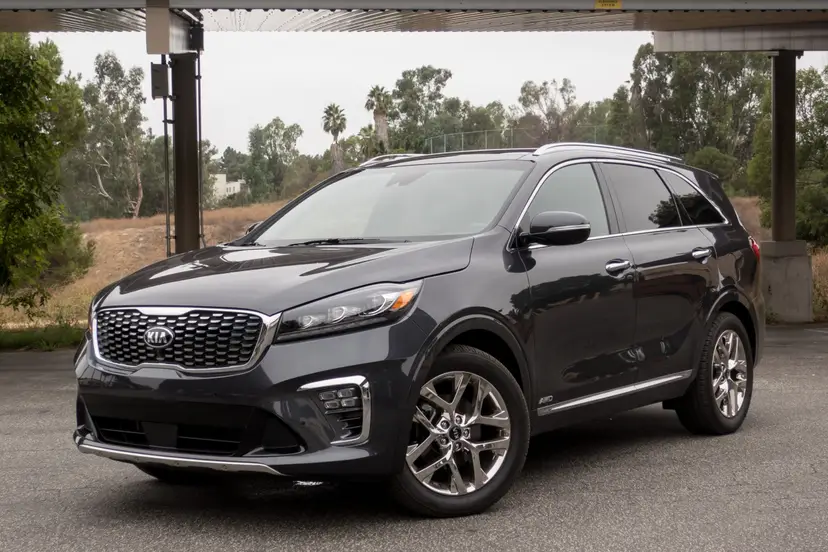
The Suburban is Chevrolet’s biggest SUV. At nearly 19 feet long, it has room for up to nine people in three rows of seats and has 39.3 cubic feet of cargo room behind the third row. It’s related to the Chevrolet Tahoe, which is little more than a shorter-wheelbase version of the Suburban with a different name that competes with the Ford Expedition. (The Expedition Max is the extended version of the Ford that competes directly with the Suburban.) The Suburban also shares its platform with the GMC Yukon XL and Cadillac Escalade ESV, both of which are more expensive and have different styling.
That’s not to say the Suburban is inexpensive. It starts at $51,895 (including a $1,295 destination charge) for a base rear-wheel-drive model with the standard 355-horsepower, 5.3-liter V-8 engine and six-speed automatic transmission. That’s the engine and transmission most trim levels get; it’s not until you get to the top-of-the-line Premier trim, which starts at $66,595, that the new 420-hp, 6.2-liter V-8 and 10-speed automatic become an option. With that high-output drivetrain and some other options, the as-tested price of our four-wheel-drive Suburban Premier ballooned to $81,770.
There’s another big SUV in Chevrolet’s lineup: the three-row Traverse. It’s roughly the same size as the Tahoe, but it’s built on a unibody platform rather than the truck-based platform that the Tahoe, Suburban and GM’s other full-size SUVs use. The Traverse is considerably less expensive than a Tahoe but offers much better third-row comfort and more carlike ride and handling. If you need to tow a trailer, however, the Tahoe has the advantage; a base rear-wheel-drive Tahoe can tow up to 6,600 pounds, and it maxes out at 8,600 pounds when properly equipped. A base front-drive Traverse, meanwhile, is only rated to tow 1,500 pounds and maxes out at 5,000 pounds for certain all-wheel-drive trims. (See the Tahoe’s, Traverse’s and Suburban’s specs compared.)
The New Drivetrain
The 6.2-liter V-8 had previously been reserved for the Escalade and the high-end Denali version of the Yukon, and beginning last year, it became an option on the Tahoe. The high-output drivetrain adds another $5,425 to the price of a Suburban Premier — that’s $2,720 for the RST 6.2L Performance Edition package and $2,705 for the RST Edition, which are bundled together — but it’s well worth the extra money because it transforms the Suburban from a modestly powered SUV into a rip-roaring truck that accelerates strongly and has passing power to spare. What’s more, the 6.2-liter V-8 works well with the 10-speed automatic: The transmission makes succinct upshifts and is quick to kick down when you need more power.
The 6.2-liter V-8 prefers premium gas to the regular gas that the 5.3-liter V-8 uses, but EPA-estimated gas mileage doesn’t take much of a hit with the larger engine: Rear-wheel-drive versions are rated 14/23/17 mpg city/highway/combined, while four-wheel-drive models are rated 14/20/16 mpg. The Ford Expedition Max, meanwhile, has a twin-turbo 3.5-liter V-6 engine and gets an EPA-estimated 17/23/19 mpg with rear-wheel drive and 16/21/18 mpg with four-wheel drive. (See the Suburban’s and Expedition Max’s specs compared.)
Our trip-computer-observed gas mileage was close to the EPA’s estimates: The 4WD Suburban got a little less than 14 mpg in city driving and 19.4 mpg on the highway.
How Well Does It Family?
My daily family vehicle is a 2012 Honda Odyssey minivan. The Suburban and Odyssey share a few specs — both have three rows of seats and nearly 40 cubic feet of cargo room behind their third rows — but that’s where the similarities end.
To test the Suburban’s family-hauling chops, my clan of five took it on a weekend trip from suburban Chicago to southern Wisconsin. We didn’t put the Suburban’s trailering abilities to the test (when properly equipped, it can tow around 8,000 pounds with the 6.2-liter V-8), but it had no trouble swallowing luggage and child-safety seats.
That said, driving a Suburban reminds you how space-efficient a minivan really is. The Suburban is nearly 2 feet longer than our Odyssey, but in terms of passenger comfort, it doesn’t have any appreciable advantages. However, if you need to carry a lot of stuff and people at the same time, the Suburban has the edge; you can pack more luggage into its long cargo area than you can into a minivan’s tall cargo space. The Suburban’s higher ride height and truck-based platform contribute to a cargo floor that’s considerably higher than a minivan’s, but it’s not dissimilar to other truck-based SUVs.
The Suburban’s second row is spacious and comfortable, with room for taller adults to stretch out. In models with second-row bucket seats, there’s a wide walk-through to the third row. The third row’s seat cushions are a little hard, but adults have acceptable space. The Expedition’s spacious third row is still one of our favorites, but its advantages are less pronounced when compared with a Suburban as opposed to a Tahoe. The Suburban’s second-row bucket seats are fixed, so you can’t slide them forward to share some of the second row’s impressive legroom with third-row passengers.
One of the most desirable SUV attributes — a commanding driving position — is fully realized in the Suburban. Once you’ve climbed into the driver’s seat, your view out the windshield is mostly unobstructed, with a line of sight above not just other cars, but other SUVs. You see things sooner than you otherwise would, but almost anyone behind you won’t be so lucky.
On the highway, the Suburban’s appeal as a road-trip companion is clear: It’s easy to hold conversations in the quiet cabin, and the long, 130-inch wheelbase gives the SUV a stable, settled feel. It’s the kind of low-stress driving experience you want for a long trip.
Same Old Shortcomings
Despite significantly improved performance thanks to the optional 6.2-liter V-8 and 10-speed automatic, familiar GM full-size SUV shortcomings — like a lack of steering feedback and numb, isolating brake-pedal feel — are still present in the 2019 Suburban.
Premier trims get GM’s Magnetic Ride Control adaptive suspension, and when the 6.2-liter V-8 is optioned, the suspension is tuned for even greater body control, Chevrolet says.
I’ve long thought Magnetic Ride Control sacrificed too much ride comfort, and that’s the case here, too: While the suspension effectively keeps body motions in check when cornering and limits up-and-down bobbing, the firm tuning means you feel every little bump and crack in the road. Whether it’s due more to the shock tuning or the low-profile tires on 22-inch alloy wheels that come with the RST Edition option, the unforgiving ride quality disappoints.
Value in Its Class
The Suburban and its full-size SUV competitors might come from mainstream brands, but with starting prices approaching or higher than $50,000, they’re priced more like luxury vehicles — and that’s not even considering the whopping price tag of our test model.
Whether the Suburban is worth that much probably depends on what you want in an SUV. If a cavernous interior, towing capability and towering views are must-haves, then the Suburban delivers. Now Chevrolet just needs to make the hot-rod 6.2-liter V-8 available on less expensive trims.
Cars.com’s Editorial department is your source for automotive news and reviews. In line with Cars.com’s long-standing ethics policy, editors and reviewers don’t accept gifts or free trips from automakers. The Editorial department is independent of Cars.com’s advertising, sales and sponsored content departments.















































